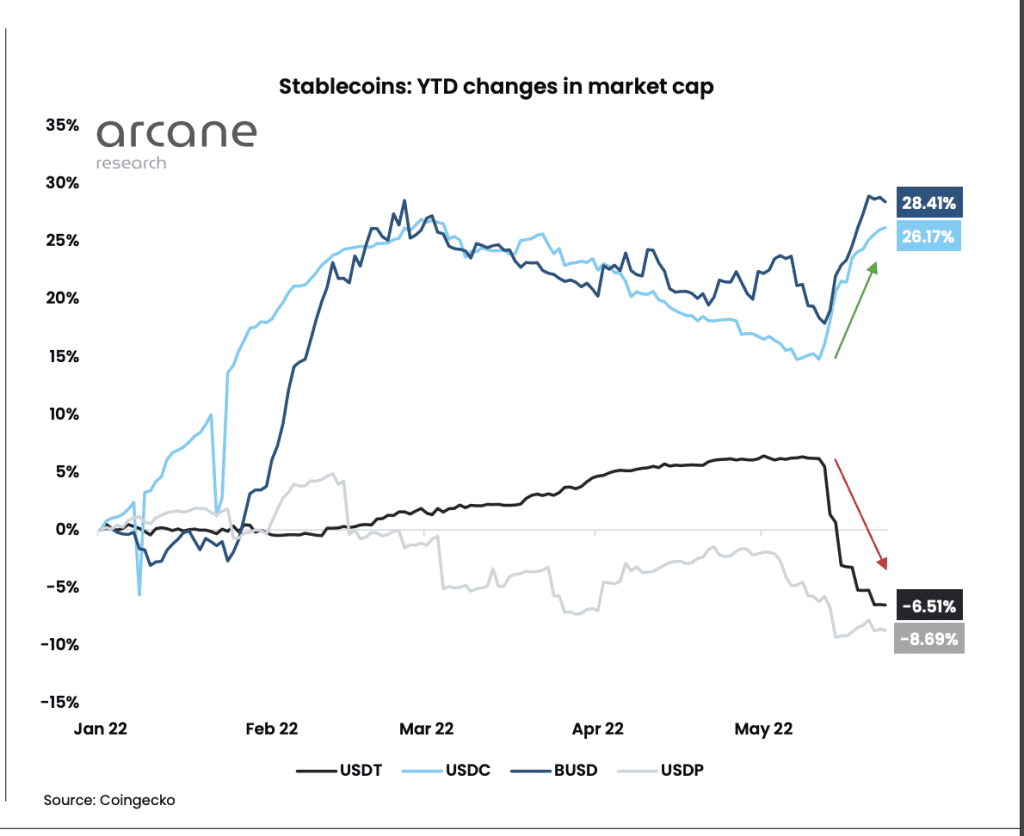Key Takeaways:
- USDT investors have withdrawn over $10bn in the past two weeks.
- TerraUSD collapse catalyst for stablecoin decline.

LAGOS (CoinChapter.com) — Tether, the world’s largest stablecoin by market cap, has witnessed an outflow of $10 billion in the last two weeks.

The massive withdrawals occurred after TerraUSD (UST), the native stablecoin of the Terra (LUNA) blockchain ecosystem — lost its peg with the U.S. dollar earlier this May. That impacted Tether, possibly due to its bad track record proving that each of its issued USDT is 100% backed by cash or cash-equivalent reserves.
Notably, Tether’s USDT circulating supply plunged from $84.2 billion on May 11 to around $73.3 billion on May 25.
Additionally, it’s worth noting that the number of Tether’s USDT in circulation has been down 6.51% in the past year. However, several experts have backed the ability of stablecoin, assuring that, unlike TerraUSD, USDT would not collapse.
Stephen Aschettino, Head of FinTech at Norton Rose Fulbright, noted that stablecoins should not be abandoned because of TerrraUSD failure. He said:
“While we have witnessed an erosion in investor confidence, we should not throw all stablecoins out the window.”
USDC, BUSD Record Growth
Although the panic over TerraUSD has drawn negative attention to stablecoins, USD Coin (USDC) and Binance USD (BUSD) have recorded significant growth this month.
Increasingly, USDC’s circulating supply, according to the recent Arcane Research report, has surged by 26% year-to-date. On the other hand, BUSD’s circulating supply was also up by 28% in the last year.

Additionally, its worth noting that these stablecoins saw smaller peg deviations following UST and LUNA collapse. For example, BUSD and USDC dropped a few cents, and USDT dipped as low as 95 cents on May 12.
Notably, Tether’s USDT strong reserve makes it a more reliable stablecoin. USDT is currently backed by holdings in the U.S. Treasuries and cash and bank deposits.
Unlike Tether, UST wasn’t backed by fiat currency held in reserve. Instead, it relied on some complex engineering where price stability was maintained through the destruction and creation of UST and LUNA.
Experts Predict Bright Future For Tether USDT, Other Stablecoins
Meanwhile, despite the massive decline in the circulating supply of the world’s largest stablecoin, experts have noted that Tether’s USDT and other projects would survive.
Gabor Gurbacs, crypto director at VanEck, said Bitcoin and USDT are the most reliable reserve assets in the crypto space. Similarly, Brad Yasar, CEO of EQIFI, noted that he doesn’t believe the stablecoin market will suffer. Yasar said:
“The asset-backed stablecoins — as long as their reserves match the number of coins in circulation — are not prone to de-pegging by market movements.”
Mark Basa, director at HOKK Finance, argued that stablecoins are the entry point for crypto adopters. As a result, they will continue to be relevant.
Tether, in a statement, also assured investors of the legitimacy of the stablecoin. The company further emphasized that USDT was backed one-to-one by dollars and could withstand any turbulence.
“It has maintained its peg because every USDT is redeemable for dollars via Tether, and as such any time the price goes below $1 investors can earn a profit by buying USDT for a discount and redeeming it with Tether.”
Tether said.


